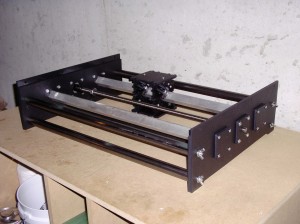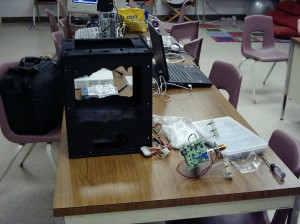If you like Cartesian robots and/or erector sets, you should check out the . It's an open source construction set for things like CNC machines, plotters, and 3D printers. It's kind of like a rapid prototyping system for automated construction/manipulation bots using cheap, easy to build parts. Its components are easy to build with a few simple tools and they're compatible with their more expensive industrial counterparts. Many of the parts utilize some interesting construction tricks so it's defiantly worth a look if you're into low cost robot construction.
Archive for the ‘Info’ Category
Contraptor Project
Tuesday, October 20th, 2009Next Project – Yet Another Homebrew CNC Mill
Sunday, October 18th, 2009The idea of a machine that takes digital designs and creates real things has always been fascinating to me. I like that I can go from an idea to an actual physical object with just a couple hours of work (or minutes in some cases), a little scrap material, and one of these machines at my fingertips. I recently came across a laser cutter for sale in my area, and I had to get it for this reason. I absolutely love what it allows me to do with my ideas, and I really see it as a "gateway" device for me. The laser cutter allowed me to build a 3D printer from open source designs and make modifications. Now I turn to my laser cutter to help me make the device that introduced me to these dream machines, the CNC router.
I've wanted one since high school and I've played around with the idea of making my own for some time now. I decided that now is as a good a time as ever to try and create my own version. Here's some of the goals I set up for this build and the reasoning behind them:
Reproducibility:
I've made my share of projects from found components, both bargains and the kind pulled from dumpsters, and while this makes each project unique, it often doesn't allow others to follow in your footsteps easily. It also means that when the project breaks it often can't be repaired easily, if at all. For these reasons, using primarily readily available parts is a must (you'll fine out why I use the qualifier "primarily" here in a second).
Cost:
I could go all out and get high quality linear bearings, ball-screws, anti-backlash nuts, and use milled aluminum components for construction, but why? If I was going to do that I'd just go out and buy a good CNC mill made by people that know a lot more about mechanical design than me or buy a good mill and add steppers. There are even a number of low cost but decent quality hobby CNC setups available, most notably the FireBall V90 from and the micRo from . These units cost $600 for the mechanical components and $900 for mechanics plus steppers, respectively. To make my design worth while, I've got to build a better system for about the same price, which its unlikely, or I've got to make a reasonably performing system that's significantly cheaper. Half the cost of a readily available kit seems like a good goal to me. This would mean that all the mechanical components of the machine should cost under $300. I envision the final version being constructed from 3/4" HDPE, which I estimate will cost about $50 for a single machine. If that is the case, all the mechanical bits should cost under $250 to meet this design goal.
Performance:
At the the very least the machine should be able to mill plastic reasonably well and preform other lighter load tasks. Lighter load tasks would include using it as a simple draw bot, 3D printing using a plastic extrusion head, and PCB milling if possible.
Modularity:
This entire project will be a learning experience for me, and I want to be able to use the mill as an experimental platform of sorts so the ability to swap out components is important. I'd also like to design a few variations of different subsystems that people could swap out depending on their desired use case. For example, I plan on using Acme rod and hex nuts under tension to help with backlash, but to cut costs you could alternatively use 1/4"-20 all thread and a coupling nut and compensate for backlash in software. Ideally you'd only have to swap out only a few parts to go from one setup to the other.
Bonus Points:
Just for fun, I'd like to design the mill such that all the machined components can easily be made on the mill itself once it's completed, much like the concept behind the . Since I don't have access to a CNC mill myself, this means that I'll have to create a "bootstraped" version with the tools I have and then mill the parts for the final version on the bootstraped machine.
I've already started making some components and I'll hopefully have some stuff to share soon.
MakerBot Update – Versioning Woes
Monday, September 28th, 2009Our MakerBot parts came in at the space so we had a build day Sunday. We made some modifications to the case design to make a cave themed MakerBot, complete with stalactites and stalagmites and a place for a nice acrylic back-lit CCCKC logo. We got everything sanded and painted, assembled the extruder and case, etc. only to find out that in batch 5 the BOM of the MakerBot changed and now our X and Y axis components that I cut out weeks ago don't work with the current rods and bearings! The Thingiverse page for the MakerBot hasn't been updated, but if you look in the subversion repo under batch 5 you'll find DXFs of the newer design. From these files it seems they've moved away from the 1/8" plywood in favor of 1/4" for the X and Y axis components in this new design as well. I've cut out another set of parts out of 1/4" Birch plywood and we'll make another go at construction on Tuesday. Hopefully we'll be up and printing by the weekend!
Labywiinth Goes to the Fair
Wednesday, August 26th, 2009Well, I headed out to the Missouri State Fair Thursday, and you know what that means,
Food on sticks,
Chainsaw art,
And robots! The Missouri 4H group set up an event called “Show Me Robots” () to show off robots in education in Missouri and what hobbyists in Missouri were working on. There were a number of KC and St. Louis groups in attendance including a few FIRST teams, BEST teams, BotBall, MAKE: KC, ROBOMO, and Kansas City Space Pirates. I was there helping with the Labywiinth display, sort of a joint project between the Kansas City Robotics Society and CCCKC.
For those that don’t know, the Labywiinth is basically a robotic Labyrinth game controlled with the Wii balance board. I actually am a late comer to this project, which was spearheaded by (software) and (hardware). Eventually we’ll be building a 10’x12’ Labywiinth game for installation at Science City. We brought our “medium” sized table (4’x4’) built by Rich and members of the Kansas City Robotics Society to the fair and set it up for people to play with.
I’m actually working on the motor controller hardware/software for the project that will allow an Arduino to easily control the actuator. I’ve got a custom motor controller design lined out but I was only able to get one built before the fair came around, so I ended up grabbing 2 Parallax HB-25 motor controllers to drive the linear actuators. The actuators used on the medium size table are two Firgelli Automations linear actuators with built in 10k potentiometers for position sensing. The potentiometers allow us to do some interesting things with the actuators, like set them up with absolute positioning like standard hobby servos or auto leveling the table. For now we’re just using them to set up some software limits (basically using the pots to mimic the functionality of physical limit switches in software) so we don’t over extend/retract the actuators.
Check out this video of the medium demo platform in action as well as one of the smaller robotic labyrinths controlled with Processing as a demo Vince set up:
Unfortunately, one of our actuators died during the event. It wasn’t completely unexpected since that platform’s been use for quite some time and the actuators extended beyond where they should more than a few times during debugging sessions and demos. Guess we’ll just have to start on the big one.




